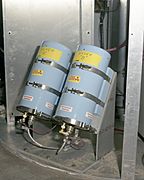Operation Sculpin facts for kids
Quick facts for kids Sculpin |
|
|---|---|
| Information | |
| Country | United States |
| Test site | NTS Area 12, Rainier Mesa; NTS Area 19, 20, Pahute Mesa; NTS, Areas 1-4, 6-10, Yucca Flat |
| Period | 1990–1991 |
| Number of tests | 7 |
| Test type | underground shaft, tunnel |
| Max. yield | 140 kilotonnes of TNT (590 TJ) |
| Navigation | |
| Previous test series | Operation Aqueduct |
| Next test series | Operation Julin |
The United States's Sculpin nuclear test series was a group of 7 nuclear tests carried out by the United States. These tests happened underground between October 1990 and September 1991. They were part of a larger program of testing nuclear weapons. This series came after the Operation Aqueduct tests and before the Operation Julin tests.
Contents
What Were the Sculpin Tests?
The Sculpin series included seven different nuclear tests. These tests were done deep underground in shafts and tunnels. The main goals were to develop new weapons, test their safety, and study their effects. Some tests also helped verify international agreements about nuclear weapons.
The Distant Zenith Experiment
One important test in the Sculpin series was called Distant Zenith. This test included an experiment named Hydroplus. The Defense Nuclear Agency (DNA) used this experiment to learn how to check if nuclear tests were done in unusual ways.
They used special computer programs called hydrocodes. These programs needed real-world information to work correctly. The Distant Zenith test helped gather this information. More Hydroplus experiments were done later in the Hunters Trophy test, which was part of Operation Julin.
Summary of the Tests
The Sculpin series included seven main tests. Each test had a specific purpose. Most of them were for developing new nuclear weapons.
- Tenabo (October 1990): This was an underground test for weapons development. It had the largest energy release, about 140 kilotons.
- Coso-Bronze, Coso-Gray, and Coso-Silver (March 1991): These three tests happened at the exact same time in the same underground areas.
- Coso-Bronze and Coso-Gray were for weapons development.
- Coso-Silver was a safety experiment, meaning it helped make sure weapons would not accidentally explode.
- Bexar (April 1991): Another underground test for weapons development.
- Montello (April 1991): This test was also for developing weapons.
- Floydada (August 1991): An underground test focused on weapons development.
- Hoya (September 1991): This test studied the effects of a weapon. It was also a "treaty verification test," which means it helped check if countries were following rules about nuclear weapons.
- Distant Zenith (September 1991): This test was done in a tunnel and studied weapon effects. It also included the Hydroplus experiment, as mentioned earlier.
Images for kids





